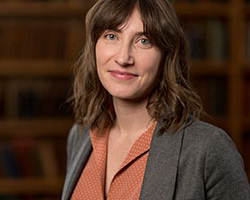In Stranger Fictions: A History of the Novel in Arabic Translation, Rebecca C. Johnson looks at the role that literary translations and adaptations played in the Arabic novel of the late nineteenth and early twentieth centuries:
By Tugrul Mende
Through Johnson’s book, we get a glimpse of literary consumption, productions, and circulation during the Nahda period — the final decades of the nineteenth century and first few of the twentieth — as seen through the lens of work by translators.
We talked about the role translators and translations played during that period, and how Arabic translations and adaptations influenced the novel.
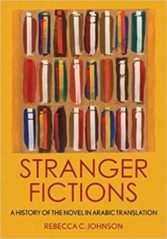 When did you first come up with the title Stranger Fictions?
When did you first come up with the title Stranger Fictions?
Rebecca Johnson: Stranger Fictions is a title that floated in and out of my consciousness as I was working on the project. One of the things that struck me when I first started to read the 19th century and think about the Arabic novel is that there are a lot of novels about somewhere else, someplace else, someone else. That was something that pointed me to the kinds of questions that I started to ask. It also refers to how standard narratives of literary development, from the perspective of translators or other agents of literary production, can themselves become strange to us, look different from how we expected them to look.
So were you looking more at the context and individuals who were translating and adapting the novels or the content of the novels?
RJ: Both. I mean, one of the things to think about in this period is that, in the historical record of the first decades of commercial print, we see this increasing frequency of publications of things called novels.
At the same time, if you look at those first decades of print, you see that the bulk of novels that were published, were published in translation. In fact, for a long time, when people were reading “novels,“ they were mostly reading translated novels.
What is interesting in this period, too, as Samah Selim has showed really beautifully, is that the boundaries between the translation and the original novel are really porous. There were many novels that were listed as translations that were in fact original novels. People writing original novels were saying that they were translations (so, pseudo-translations). And then you sometimes have translations and European language texts inside original Arabic novels. You have novelists who are translators and translators who are novelists. The border between translation and original novel was much more porous that we would now imagine. That is really what animated the project, and what I discovered is that we as scholars often have too rigid a distinction in our mind between the translation and the original work. We think of the original work as primary and the translation as secondary. But when you think of it instead as an single literary field that contains a porous border between the translation and the original, then you start to think of translation as a form of novelistic production, as critique, as interpretation. It can even be theory.
This is the way that I approached the material. I’d read the novels themselves, and around the novels. The translators’ introduction is such a rich resource for us, as researchers. In their introductions, translators would situate their novels for their readers. They would even write a history of the form or a theory. So I look at this wide field: I am using the prefaces, I am looking at articles in journals at the time that are about translation, and I am also looking at the texts themselves.
When translators looked for projects at that time, what was their method of discovery? Their motivations?
RJ: There were hundreds of novels translated. People were being motivated and finding their sources in so many different ways. At the same time, their choices were also part of the idiosyncrasy of circulation at that point. What was available at bookstores, at private libraries in other kind of libraries, what was taught in schools?
Some translations were the result of state projects, like the Bulaq press. And then you have translations that were performed by religious organizations like the missionary societies, those would be part of their employment contract which would be similar to Bulaq or translations schools. But then, there were also individual translators working their day jobs, maybe at the postal service, and moved by their own love of a work, who translated on the side and sent it to a press. These were sometimes translations of novels that were internationally popular; they were international literary phenomena and simultaneously being translated in other languages, too.
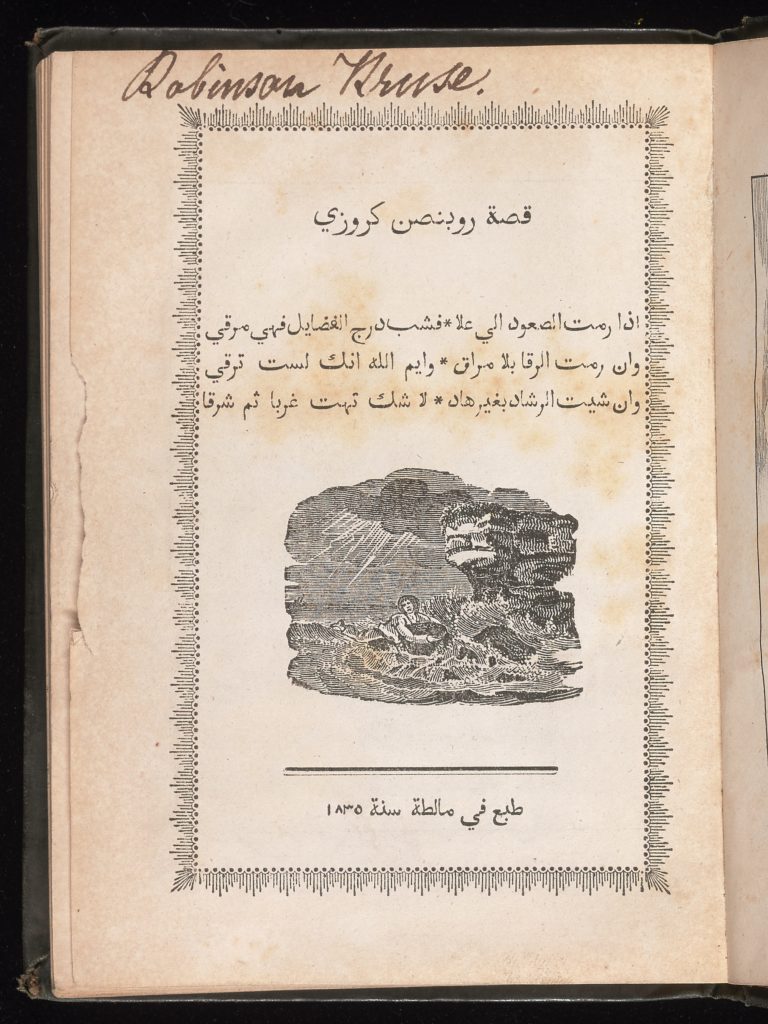
Title Page, Qiṣṣat Rūbinṣun Kurūzī [Translation of Daniel Defoe, Robinson Crusoe]. Malta: Church Missionary Society Press, 1835.
Can you elaborate on what you mean by Transnational Imagination? Is it connected to Benedict Anderson’s famous Imagined Communities?
RJ: It is definitely in conversation with Benedict Anderson and the kind of paradigm that his work produced, which is the paradigm that poses the novel as the quintessential national form, providing a national imaginary for its readers. That is part of the reason why these translations haven’t been studied. They are about somewhere else, and don’t give us evidence of nation building. If we focus on original novels, written in Arabic, as way of trying to find the origins of national literature, then translations are left out of that field. Arabic print culture is not exclusively national, it is also transnational, even today. It circulates outside the nation state and not as a secondary process, its primary process is to circulate inside and outside the nation state at the same time.
In the Nahda, this is true as well. There were European newspapers coming in by steamships that were translated into news for Arabic journals. You have also Arabic newspapers being printed, from Sao Paolo to London, and excerpting each other in their journals. You would have a journal in Beirut running a reprint of an article that was published in Cairo and vice versa. The way that people read was not confined to things that circulated nationally. When they read, they didn’t just read news about their nation. The novel is part of that print environment.
When you have such a vast corpus, how did you choose what was foundational for your research?
RJ: It is really difficult. It is both a vast corpus but it is also self-selected because not everything is available. As a researcher, you have access to a certain number of novels, but you know there is a much larger number out there. What I try to do is both to maintain a micro-level focus, where I could think about a specific text, and then a larger focus where I think about it in its context and as it exists in a wider field, which I glean from catalogue records, reviews, book announcements. So I try to have a large-scale view and a small-scale view at the same time. It is really challenging and there is so much work left to do. This is just one slice of it.
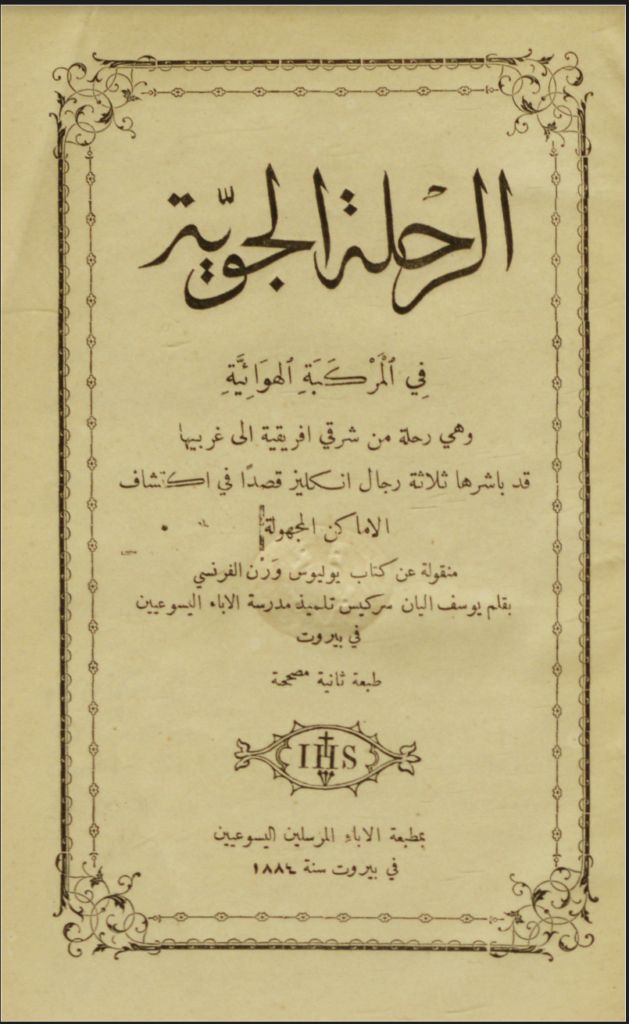
Title page, Yūsuf Sarkīs, al-Riḥla al-jawwiyya fī al-markaba al-hawā’iyya [Translation of Jules Verne, Voyage en ballon], 1875
How much of the work was archival, and how much is now digitized?
RJ: I have been working on this project since my dissertation. When I started this project, nothing was digitized. When I finished the project, a lot of things were digitized, but not everything. But my experiences researching before digitization were useful in their own way. I was really interested in the serialized form of the novel, when I first started the project. I spend a lot of time in Dar al-Kutub in the periodical room. I would get a year of a journal and I would look through it, looking for serialized novels. Along the way, I saw what the context was for the novels. That was a really formative experience for me, because it is how I started on a very material basis to understand the novel as part of print culture and what that means. The novel is part of a larger series of discourses.
Without that predigitized research, I wouldn’t have followed the same research lines. If I would have started the research process after everything was digitized and keyword-searchable, I think it would have been a very different project. It wouldn’t have looked at the same kind of materials. The way journals laid out the serial novels at their pages is still really interesting to me. For example, some novel sections were printed in such a way that you as a consumer could cut it out, and make your own book out of it. You could take it to the binder and put it on the shelf afterwards. If you don’t have access to the material, it is hard to imagine the multiple ways that novels circulated.
Does Muhammad Husayn Haykal’s Zainab still stand as any sort of “first” among novels?
RJ: I think the scholarship in general has been more and more skeptical about these kind of “first” designations. I think we need to get away from the language of firsts altogether. As soon as you define something as a first x, it means you have a category in which it fits. You are actually applying a definition that exists prior to the object itself, rather than asking why this work of literature is calling itself a novel, and starting from there. I think Zainab is really interesting, because it came at the end and height of the popularity of translated fictions. It was part of the field of literary production that included translations as well. Elliot Colla has a really great article about Zainab, and he writes about how Zainab became the first novel. That is about the way the novel has been incorporated into national projects but also how scholarship has thought about it as a national form. That was the reason because Zainab was considered to be the first novel, but what if we open up that definition of the novel to how novelists and translators themselves defined the form? (Also read: “How Zaynab Became the First Arabic Novel“)
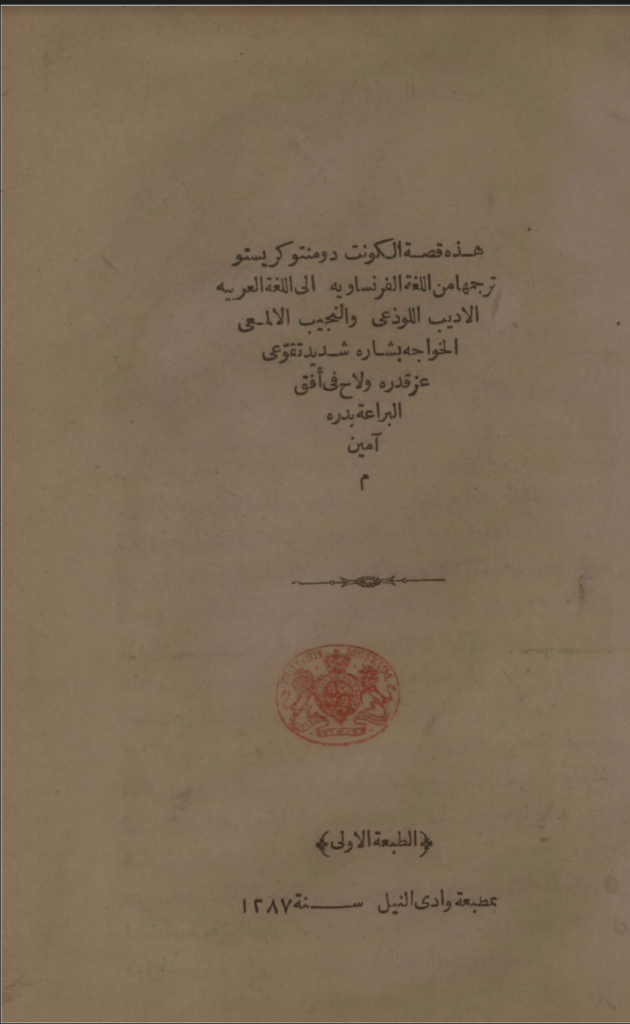
Frontispiece, Bishāra Shadīd, Qiṣṣat al-Kūnt dū Mūntū Krīstū [Translation of Alexandre Dumas, Le Comte de Monte Cristo], 1871.
In what way did your work help you to re-examine the Nahda period?
RJ: Thinking about translations is really useful for thinking about the Nahda. We have moved very far away from seeing the Nahda as a belated copy of the European original. I think looking at the translations themselves is something that really helps us to see the way that the reception model of literary modernity is untenable (that is, how Arabic literary modernity was produced by “receiving” European models). Translation is an active process. It produces thought, literature, critique, and doesn’t just copy or receive an original. And if you think about it that way, you see translators as agents and how they revise what they are reading. They are reading much wider in their own context and producing new thoughts. This is important to Nahda studies. The field has changed its view of where you find agency. And it has become interdisciplinary, which is great. Material and intellectual histories are being thought together: print culture and literary studies, for example.
How is the influence of translations during the Nahda period different from the influence translations have on Arabic novels today?
RJ: Today, I was looking at Huda Fakhreddine’s work, where she thinks about translators who were poets and poets who were translators, I think it is still a good idea to think about translations and originals coexisting in the same literary field, and how people write and read both translations and work written in its original language. From my very own small experience doing literary translation, I learned that translation is not just you and the text. As soon as you sit down, you don’t do it alone, your translation is a translation of the text in front of you, and the conversations about the text and the literary fields around the text. When you start to translate yourself, you start to understand, how collective the process really is.
Tugrul Mende is a regular contributor to ArabLit.
